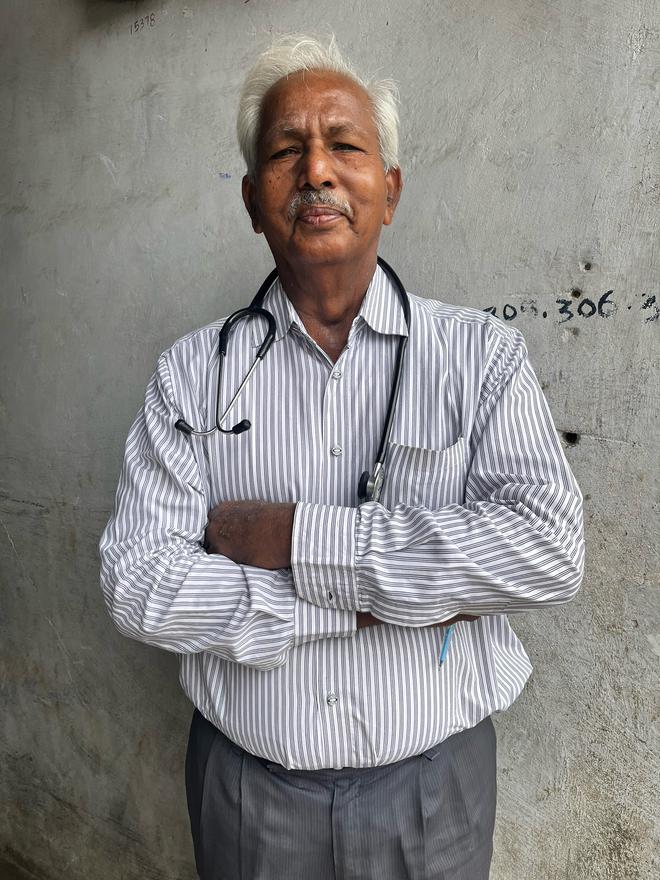On National Doctor’s day that is celebrated on July 1 every year in India, we travel to Suryapet in Telangana state to meet Dr K Ranga Reddy. His small clinic is on the service road to Warrangal, opposite the new bus stand . Here, patients have already lined up, waiting for the doctor to arrive . When he does, silver-haired, 70-year-old Dr K Ranga Reddy arrives on foot from his home which is one kilometre away. He is Suryapet’s ₹20 doctor’ — because he charges only ₹20 as his consultation fee.
Dr Reddy’s assistant opens the clinic after he arrives. The clinic comprises two very sparsely furnished rooms, nothing fancy. Patients greet him with a namaste and start rattling out their complaints: body pains, fever, loose motions, dizziness ... the list goes on. Dr Reddy first attends to the one who needs urgent attention. A young man and a teenage girl. High fever and diarrhoea. They need to be put on IV fluids. After these two, he patiently listens to the others. He requests me to wait and only after he is done with consultations and meeting with medical representatives, does he settle down to tell his story.
Why does he charge ₹20 only? He explains that he used to charge ₹5, then increased it to ₹10 and gradually, his patients voluntarily started paying him ₹20.
Highlights
- Dr K Ranga Reddy in Suryapet charges only ₹20 as fee from patients. in the begining his fee was ₹5
- He is 70-years-old, never misses to reach the clinic on foot, doesn’t own any vehicle of his own
- Even during the COVID-19 lockdown, Dr Reddy kept his clinic open, only to clear doubts of his patients
- In 1978 he was elected as Gandhi Hospital’s students General Secretary. He was later elected as the President
He might be a sought-after doctor in Suryapet, but he didn’t aim to take to the career . He says, “How can a poor man’s son who tilled the land, nurture such a dream? Going to school and college and eating three meals was a luxury for me. So I didn’t aspire to become a doctor. What I did dutifully was attend school and college without fail. I think I was there standing and listening to anyone who was discussing anything knowledgeable.”
Ranga Reddy took a medical entrance examination because of a friend. “My friend suggested I write the entrance examination because he was doing so. There were 15 seats reserved from this district and we were hopeful someone or the other would get in,” he recollected. He did and completed his MBBS from Gandhi Medical College in 1983.
Dr Reddy recalls with a smile that during his stint at medical college, his friends encouraged him to contest in all the college elections. “I first became the General Secretary, then student’s President and even became the president; it was a good time. While at medical college, all I could think of was I will be able to treat the needy.”
I persist in asking him why his charges are so nominal. “What will I do with anything more than I need? What will anyone do with what is more than necessary? I aim to serve. Instead of paying me a hefty consultation, they can use that money to buy something and eat.”

What about running his household? “I don’t know how my wife managed. She has never complained. We weren’t leading a luxurious life. I was somehow able to make my two sons study well. I know it would not have been easy at all.”
He shares that his friends and well-wishers even constructed a place for him to run a clinic. With the earning from his practice, Dr Reddy could not have run a bigger clinic. “I was in losses and behind in my EMI. Well-wishers who invested in me also couldn’t get their money back in time. As I didn’t want anyone to suffer on account of my principles, I rented out that place to first pay off the people I owed. My sons (settled in Melbourne, Australia) paid off the entire loan after they started earning. My family has been my biggest support in this journey,” he adds.
To date, Dr Ranga Reddy doesn’t own a vehicle, he either walks from home to the clinic or takes a ‘shared auto’. “My sons bought a car and asked me to use it. I don’t know how to drive, nor can I afford a driver, so the car is a burden for me. My sons use it when they visit home. I also work with an NGO, when I go to that place, I take an auto; otherwise, I prefer to walk.”







